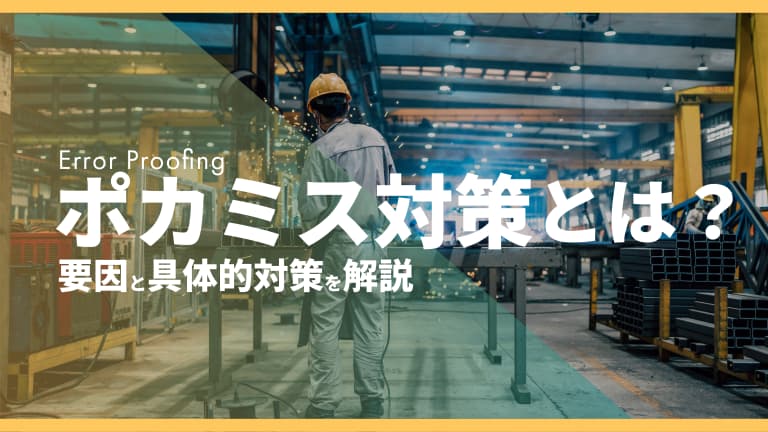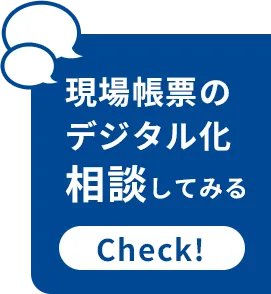The most important thing to be careful of in manufacturing sites is preventing accidents caused by workers. Most accidents are not sudden, but rather are caused by overlooking signs of danger, known as "near misses."
Why do manufacturing mistakes happen? What can be done to prevent them?
table of contents
You may make careless mistakes in your personal life, and the same is true at work.
When there are many processes that depend on workers, such as operating equipment or visually checking inspections, the possibility of mistakes occurring is even higher.
In order to avoid the release of defective products and market complaints, it is important to ensure that measures are taken to prevent careless mistakes.
This time, we will explain the causes and measures to prevent "careless mistakes" in the manufacturing industry.
Causes of manufacturing mistakes
In the old days when the same products were mass-produced, the tasks that workers had to learn were simple.
However, in recent years, the manufacturing industry has been required to produce a wide variety of products in small quantities, and the number of items that need to be checked during manufacturing has increased compared to back then.
If we continue to produce it in the old way, relying on workers, it is easy for careless mistakes to occur.
Nowadays, automation is progressing in the manufacturing industry, and robots and other tools are being introduced to prevent mistakes that workers are prone to make.
However, mistakes still happen, and we will explain the causes of these mistakes.
Mistakes due to human error
Even though automation of manufacturing processes has progressed, there are not many places that have managed to automate everything.
Generally, robots and other equipment are introduced in processes that involve handling heavy objects or that require repeatable precision.
However, if a worker supplies materials or parts before or after the process performed by the robot, problems can occur if the worker makes supplying errors.
The procedures for supply work are set out in a manual, and if the work is carried out according to the procedures, mistakes should not occur. However, as workers become accustomed to the work, they may start to do it their own way and skip over the checks specified in the manual.
Workers are educated and trained to avoid making mistakes, but being human, they are prone to making mistakes due to fatigue and stress.
Download examples of recalls and complaints that can be prevented with field reports
Mistakes due to the work environment or equipment
There are mistakes that can be induced by the work environment and equipment.
In harsh working environments, machines are also put under strain.
For example, temperatures near iron melting equipment can exceed 100 degrees.
If equipment is installed in such a location without adequate heat countermeasures, it may be affected by heat and cause breakdowns or malfunctions.
Additionally, in places where there is dust in the air, foreign objects can get into the robot's drive units, causing malfunctions.
Furthermore, dust can accumulate on the inventory list used to identify parts, making the letters unreadable.
In particular, dust and dirt can cause reading errors if they land on barcodes or QR codes.
If the work environment is not managed, unexpected equipment problems can occur.
Countermeasures against mistakes caused by human error
In order to prevent mistakes from recurring at manufacturing sites, thorough cause analysis is important.
When analyzing the causes of mistakes, people tend to focus only on human error, but if work mistakes are dismissed as simply human error, there is a high chance that the same mistake will happen again.
To prevent mistakes, We need to analyze why human error occurred..
Here we will explain how to prevent human error.
Manual restructuring
If a mistake occurs because work is not being done according to the manual, we will consider restructuring the manual.
The worker will be interviewed to find out why the procedure was not followed.
For example, if the manual says to assemble part A before installing part B, what would you do if, in actual practice, it was easier to install part B before installing part A?
Workers may choose the method that is easiest for them.
However, if part A must be assembled before part B can be attached for quality reasons, The key is to include the importance of assembly order in the manual. It will be.
If the manual is simply a procedure manual, adding work points and quality points will help workers understand the importance of assembly order, making them less likely to change the procedure based on ease of use alone.
When reconstructing a manual, it is a good idea to use documents that clearly state the work procedures and work instructions.
Prevention with a checklist
Depending on the process, you may have to select the correct part from a large number of parts and assemble it.
If there are only two or three types of parts to choose from, there may be less chance of making a mistake, but if there are ten, it is natural that it is easier to make a mistake.
To help prevent such mistakes, you can use a checklist.
A list of parts is prepared in advance in the order in which they will flow through the process, and the assembled parts are checked in order to confirm their accuracy.
If checks are carried out thoroughly, mistakes will be eliminated, but this places a heavy burden on the workers, so it is a good idea to use equipment to select parts, etc.
Understanding your health
Workers are human beings, and as humans, there will be days when they feel unwell. When they are unwell, they are more likely to make mistakes.
In manufacturing sites, managers and supervisors should check the health of workers every morning. If workers appear unwell, they should be given a shift or other appropriate measures.
Download examples of recalls and complaints that can be prevented with field reports
Countermeasures for equipment-related mistakes
If there are measures to prevent mistakes that place a burden on workers, consider measures to prevent mistakes with equipment. This section explains how to prevent mistakes with equipment.
Review of work environment
As mentioned earlier, a poor working environment can lead to equipment problems.
The facility is equipped with many sensors.
The type of sensor varies depending on what you want to detect, but there are some that use light and some that use magnetic fields.
The working environment can have an impact, especially when sensitive detection is required.
Barcode Management
Informing workers which part to choose from a large number of parts is an area where equipment excels.
And by utilizing two-dimensional codes such as barcodes, work errors can be prevented.
By managing a large number of parts using barcodes, mistakes such as "misplaced parts" or "misselected parts" can be found on the spot.
When it comes to reading barcodes, using dedicated equipment such as a handheld terminal makes it easy for anyone to operate, which will help standardize the process.
By linking it to a tablet device, you can also look up information about storage locations and products on the spot.
By utilizing barcodes and tablet devices, human error can be prevented and even beginners can be trusted to carry out the work with confidence.
summary

When it comes to "careless mistakes" in manufacturing, if you have dismissed them as human error, you should thoroughly analyze the cause and take measures.
If you rely solely on human-related measures, there is a risk of the problem recurring, so be sure to consider taking measures on the equipment side as well, if necessary.
Download examples of recalls and complaints that can be prevented with field reports


This is the editorial department of the Field Document Research Institute!
This blog is operated by CIMTOPS Corporation., which develops and sells the field document electronic solution "i-Reporter."
We will be delivering industry information on a regular basis to help those of you working hard to promote digital transformation in the workplace, so please take a look!











